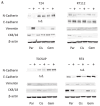Sulforaphane Inhibits Adhesion and Migration of Cisplatin- and Gemcitabine-Resistant Bladder Cancer Cells In Vitro
- PMID: 38474751
- PMCID: PMC10934724
- DOI: 10.3390/nu16050623
Sulforaphane Inhibits Adhesion and Migration of Cisplatin- and Gemcitabine-Resistant Bladder Cancer Cells In Vitro
Abstract
Only 20% of patients with muscle-invasive bladder carcinoma respond to cisplatin-based chemotherapy. Since the natural phytochemical sulforaphane (SFN) exhibits antitumor properties, its influence on the adhesive and migratory properties of cisplatin- and gemcitabine-sensitive and cisplatin- and gemcitabine-resistant RT4, RT112, T24, and TCCSUP bladder cancer cells was evaluated. Mechanisms behind the SFN influence were explored by assessing levels of the integrin adhesion receptors β1 (total and activated) and β4 and their functional relevance. To evaluate cell differentiation processes, E- and N-cadherin, vimentin and cytokeratin (CK) 8/18 expression were examined. SFN down-regulated bladder cancer cell adhesion with cell line and resistance-specific differences. Different responses to SFN were reflected in integrin expression that depended on the cell line and presence of resistance. Chemotactic movement of RT112, T24, and TCCSUP (RT4 did not migrate) was markedly blocked by SFN in both chemo-sensitive and chemo-resistant cells. Integrin-blocking studies indicated β1 and β4 as chemotaxis regulators. N-cadherin was diminished by SFN, particularly in sensitive and resistant T24 and RT112 cells, whereas E-cadherin was increased in RT112 cells (not detectable in RT4 and TCCSup cells). Alterations in vimentin and CK8/18 were also apparent, though not the same in all cell lines. SFN exposure resulted in translocation of E-cadherin (RT112), N-cadherin (RT112, T24), and vimentin (T24). SFN down-regulated adhesion and migration in chemo-sensitive and chemo-resistant bladder cancer cells by acting on integrin β1 and β4 expression and inducing the mesenchymal-epithelial translocation of cadherins and vimentin. SFN does, therefore, possess potential to improve bladder cancer therapy.
Keywords: bladder cancer; cadherins; chemotaxis; drug-resistance; integrins; sulforaphane.
Conflict of interest statement
The authors declare no conflicts of interest. The funders had no role in the design of the study; in the collection, analyses, or interpretation of data; in the writing of the manuscript; or in the decision to publish the results.
Figures








References
-
- Bonucci M., Geraci A., Pero D., Villivà C., Cordella D., Condello M., Meschini S., Del Campo L., Tomassi F., Porcu A., et al. Complementary and Integrative Approaches to Cancer: A Pilot Survey of Attitudes and Habits among Cancer Patients in Italy. Evid. Based Complement. Altern. Med. 2022;2022:2923967. doi: 10.1155/2022/2923967. - DOI - PMC - PubMed
-
- Kanimozhi T., Hindu K., Maheshvari Y., Khushnidha Y.G., Kumaravel M., Srinivas K.S., Manickavasagam M., Mangathayaru K. Herbal supplement usage among cancer patients: A questionnaire-based survey. J. Cancer Res. Ther. 2021;17:136–141. - PubMed
MeSH terms
Substances
Grants and funding
LinkOut - more resources
Full Text Sources
Medical
Research Materials
Miscellaneous

